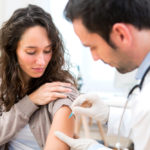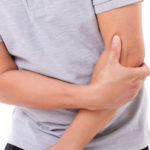Around 125 million people worldwide are affected by psoriasis. Unfortunately, however, knowledge about this chronic inflammatory skin disease is still limited. We want to educate by passing on valuable knowledge – both to those affected by psoriasis and to the general public. So here’s psoriasis in numbers!
World Health Organization – Global Report on Psoriasis from the World Health Organization
Psoriasis is “a chronic, non-communicable, painful, disfiguring and disabling disease”, as described by the World Health Organization (WHO) in its “Global Psoriasis Report”.
The primary aim of the report is to raise public awareness by means of well-founded statistics and facts about the chronic inflammatory skin disease. In addition, the WHO describes how the disease affects the life of a patient with psoriasis. It also encourages the public to improve the integration of people with psoriasis in their social environment.
Unfortunately, the knowledge, acceptance and understanding of psoriasis has not yet reached the necessary and desired level in the public. The Global Psoriasis Report by the World Health Organization therefore makes a valuable contribution to the education about psoriasis.
It is time to “destigmatize” psoriasis in society and to enable those affected to deal with their skin disease more openly.
Psoriasis in figures and statistics
Everyone has their own psoriasis. Psoriasis is a diverse and individually varying skin disease that affects both women and men, regardless of age, origin and ethnicity. The number of meaningful studies on psoriasis is limited and therefore often shows only a part of “the big picture”.
The following figures and statistics therefore do not necessarily claim to be complete – but they do claim to be worthy of attention!
Figures around psoriasis
- 125 million people are affected worldwide.
- The incidence of psoriasis in different countries is between 0.09% and 11.43%.
- The age group that’s statistically and on average the most frequently affected is between the ages of 50 and 69 years.
- Up to 34.7% of those affected by psoriasis also suffer from psoriatic arthritis as a concomitant disease and up to 69% suffer from changes in the nails (psoriasis of the nails).
Symptoms of psoriasis according to the documented frequency
- 92 %: Scaling of the skin (plaque)
- 74 %: skin rash
- 72 %: Severe itching
- 69 %: Skin redness (erythema)
- 62 %: Pain in the affected skin areas
- 42 %: Joint Pain
- 39 %: Cracks in the skin
- 34 %: Dry skin
- 27 %: Fatigue
- 23 %: Swelling
- 22 %: Nail changes
- 20 %: Burning of the skin
- 20 %: Bleeding of affected skin areas
Quality of Life
However, it is far from sufficient to describe the physical symptoms of psoriasis in figures. Because psoriasis is not a purely external, cosmetic problem. For those affected, psoriasis also means severe emotional stress and impairment.
The quality of life often suffers from the negative effects. According to statistics and surveys of patients, these include, for example
- Physical disfigurement,
- Social exclusion,
- Shame,
- Stigma,
- Lack of self-confidence,
- Depression,
- Activity restrictions,
- Discrimination,
- Loneliness,
- Loss of physical and mental productivity.
A study conducted in the United States and published in 2015 examined the areas of the life of patients with psoriasis that are most frequently affected by the psychological effects of the skin disease:
- 98% Emotional life
- 94 % Social life
- 70 % Family life
- 68 % Professional career
- 38 % Physical functional level
- 21 % Training
- 17 % Sexual activities
Psoriasis in numbers: Economic burden
Psoriasis is undisputedly a financial burden – both from the point of view of patients and from the perspective of the health care system and the economy. Concrete data on the costs of treating psoriasis are hardly available. It is difficult to make generally valid and binding statements regarding the costs, as these depend strongly on individual characteristics.
However, the following survey data from various sources in recent years can provide insight:
- Average co-payment for treatments and medication for psoriasis patients in the USA: $ 2,528 per year.
- Average co-payment for outpatient care per patient in Switzerland: annually CHF 600-1,100 for mild forms of psoriasis and annually CHF 2,400-9,900 for severe forms of psoriasis.
- Incapacity to work due to psoriasis per year in Germany: on average, 4.9 working days.
The treatment of psoriasis is expensive and often necessary for life. The individual prices of the drugs vary enormously. Starting with comparatively cheap preparations for local treatment (topical therapy) up to very expensive treatments using biologicals.
Similar to many other skin diseases, unfortunately, the necessary treatments and medication for psoriasis are not fully covered by the general medical basic care.
Psoriasis in figures: 10 facts about psoriasis
Psoriasis is an extensive skin disease about which there is much to report. We therefore present you with ten facts that are an excellent basis for giving others, especially unaffected people, a first overview of psoriasis.
- Around 125 million people worldwide are affected by psoriasis. In Germany alone, it is estimated that around two million patients are affected.
- Psoriasis is NOT contagious and cannot be transmitted to other people.
- To date, psoriasis is not curable – but it is easily treatable.
- The most common form of psoriasis is psoriasis vulgaris (also known as plaque psoriasis or “common” psoriasis) with about 80% of all cases.
- According to scientists, our genes are involved in the development of psoriasis. Genetically, however, it is not the disease itself that is transmitted, but only the predisposition to it. There are also a number of triggering factors (triggers) that can cause or aggravate the disease or individual relapses.
- Around 30% of those affected by psoriasis also suffer from psoriatic arthritis, a chronic inflammatory disease of the joints with involvement of the skin.
- The characteristic psoriasis (plaque) is caused by an excessive production of new skin cells. In healthy people, skin renewal takes about 25 to 27 days, in psoriatic people only five to seven days.
- Psoriasis is treated locally (local therapy) for example with creams, ointments, shampoos and light therapy. Moderately severe and severe forms of psoriasis are also treated internally (systemic therapy) using drugs such as methotrexate, fumaric acid ester or biologicals.
- Depression is not an uncommon side effect of psoriasis. Those affected suffer from fear and shame and often withdraw from their social life.
- Psoriasis can affect the most diverse parts of the body. Psoriasis occurs particularly frequently on the head, behind the ear, on the forearms / lower legs, palms and soles of the feet (palmoplantar psoriasis) and nails (nail psoriasis). In addition, body folds (inverse psoriasis) and the genital area can be affected.
Psoriasis in numbers: More frequent, more extensive and more stressful than many people think
Psoriasis is not curable to this day. In addition, psoriasis is chronic and unpredictable in terms of its triggers and the course of symptoms. For the patients, this means results in the necessity for lifelong treatment.
However, treatment of the individual symptoms is greatly insufficient. If we look at the skin disease psoriasis in figures, it becomes clear that patients have to fight a number of psychological complaints. A large part of these complaints and impairments are caused by a lack of knowledge about psoriasis.
Every patient has his or her own psoriasis – and it is imperative to deal with all facets of the disease. If you, as an affected person, are familiar with your psoriasis, with your personal triggering factors, the severity and course of your psoriasis, you can take appropriate measures.
In order to reduce the negative effects on the lives of those affected, it is also important to create and strengthen the knowledge and awareness of this disease in society!
What are your experiences? Do you recognize yourself in the figures and statistics mentioned? Do you carry out “educational work” in your personal environment? We are looking forward to your experience report – also in our Facebook group!
FAQ on psoriasis in numbers
How common is psoriasis?
Around 125 million people worldwide are affected by psoriasis. Theoretically, psoriasis can occur at any age, in both women and men. The chronic inflammatory skin disease progresses in phases. The clinical picture of psoriasis varies. Psoriasis can occur in different forms and manifestations and on different parts of the body. Very often, psoriasis is accompanied by various accompanying diseases, such as psoriatic arthritis, diseases of the cardiovascular system, metabolic diseases and disorders, autoimmune diseases, anxiety disorders and depression.
What is the most common form of psoriasis?
Psoriasis vulgaris occurs in about 80 percent of all patients and is therefore the most common form. It is also called plaque psoriasis or common psoriasis.
How many people suffer from psoriasis arthritis in addition to psoriasis?
Experts estimate that about 30% of all people affected by psoriasis also suffer from psoriatic arthritis. Anyone who carries the disease can get it.
Does psoriasis occur equally frequently worldwide?
No. It varies between different countries and population groups. The risk of occurrence is between 0.09 and 11.43 percent – depending on a person’s origin.
Find all sources
Sources:
Armstrong A.W., Schupp C., Wu J., Bebo B. (2012): „Quality of life and work productivity impairment among psoriasis patients: findings from the National Psoriasis Foundation survey data 2003–2011“, in: PloS One. URL: https://www.ncbi.nlm.nih.gov/pubmed/23285231 (accessed on 19.01.2020)
Gelfand J.M., Feldman S.R., Stern R.S., Thomas J., Rolstad T., Margolis D.J. (2004): „Determinants of quality of life in patients with psoriasis: a study from the U.S. population“, in: Journal of the American Academy of Dermatology. URL: https://www.ncbi.nlm.nih.gov/pubmed/15523347 (accessed on 19.01.2020)
Globaler Bericht zur SCHUPPENFLECHTE. Autorisierte deutsche Übersetzung des „Global Report on Psoriasis” der WHO 2016: https://apps.who.int/iris/bitstream/handle/10665/204417/9789241565189-ger.pdf (accessed on 19.01.2020)
Pariser D., Schenkel B., Carter C., Farahi K., Brown T.M., Ellis C.N. and Psoriasis Patient Interview Study Group (2015): „A multicenter, non-interventional study to evaluate patient-reported experiences of living with psoriasis“, in: Journal of dermatological treatment. URL: https://www.ncbi.nlm.nih.gov/pubmed/26138406 (accessed on 19.01.2020)
Sampogna F., Tabolli S., Abeni D. (2012): „Living with psoriasis: prevalence of shame, anger, worry, and problems in daily activities and social life“, in: Acta Dermato-Venereologica. URL: https://www.medicaljournals.se/acta/content/abstract/10.2340/00015555-1273 (accessed on 19.01.2020)
Stern R.S, Nijsten T., Feldman S.R., Margolis D.J., Rolstad T. (2004): „Psoriasis is common, carries a substantial burden even when not extensive, and is associated with widespread treatment dissatisfaction“, in: The Journal of investigative Dermatology. Symposium proceedings. URL: https://www.ncbi.nlm.nih.gov/pubmed/15083780 (accessed on 19.01.2020)

Bernd is one of the founders of Simply Psoriasis. He has been suffering from psoriasis for more than 20 years, but sees the chronic skin disease with more composure than a few years ago (which was a hard work). Nevertheless, he is very keen to make psoriasis easier and more socially accepted.









Last Comments